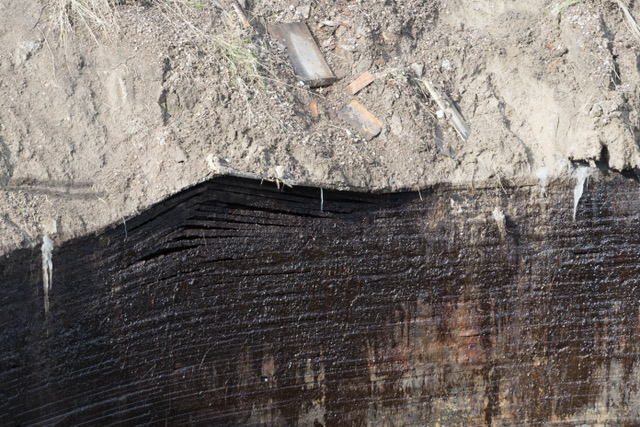It was the invisible made visible. A wooden underground oil tank at Fairbank Oil, of the 1870s, was recently brought into view when the plank “lid” was removed.
“It was a marvel of engineering and was employed here for 100 years,” said Fairbank. “These tanks were a work of great craftsmanship,” says Charlie Fairbank. “They held up to 8,000 barrels of oil without leaking a drop for about 100 years.”
It was not the wood that made these tanks leak proof. It was the dense clay of Petrolia and Oil Springs. The meticulously constructed wooden rings of the tank merely reinforced the clay walls. These circular tanks, usually 30 feet in diameter, were dug 60 feet below surface above the top rock.
After workmen dug the tank, they trimmed the clay walls with spades, then starting at the bottom they would ring the walls with pine lumber cut in the form of the segment of a circle. They shaped the timber to fit the circular wall of the tank. Each segment was from three to four-feet long, five inches wide and one-inch thick.
“When finished, it is a nice sight to look at,” John D. Noble told the first Petroleum Congress held in Paris in 1900. Noble designed the ingenious tanks in the late 1860s…for good reason.

This rare sight shows the intricate craftsmanship in layering the timber that reinforces the clay walls of the underground tank. The tank dates back to the 1870s and had timbers covering on the top.
Photo by Al Hayward
Inspired by Disaster
In the summer of 1867, two horrific fires in Petrolia raged for weeks, running rampant through oil fields. The July fire at John D. Noble’s oilfield consumed 12 acres. In August, another fire consumed 20 acres – the equivalent of nine football fields. Each of these fires raged for two weeks.
In both disasters, flames shot 100 feet into the air and the uncontrollable infernos were so incredibly hot, they melted steel tanks. John D. Noble’s oil burst from tanks, flowed through ditches and into Bear Creek, appearing as a fiery dragon winding through the town. It was the Kuwait of its day, finally extinguished by sapping the wells and adding wagonloads of manure.
Shaken by the fires, Noble was inspired to ensure such horrors would not be seen again. His underground tanks were protected from lightning, kept the oil at an even temperature, and stopped the oil of above-ground tanks from fuelling any future fires. The clay really was impervious to leaks. Never again did Petrolia suffer such monumentally destructive infernos.
Who Was John D. Noble?
Noble was among Petrolia’s first oil operators, arriving in 1866, the year the huge King Wells triggered Petrolia’s boom of four decades.
He had heard about the oil when he was a vessel owner in Kingston. He later explained to the 1890 Royal Commission on Minerals in Ontario, “A schooner came back covered in oil and I asked the captain what was the cause of it. He said they had struck oil at Sydenham and could not stop the wells flowing and that it was coming down the river a foot thick on top of the water…so I came here to look into the matter… What the captain referred to was caused by the flowing wells of Oil Springs. When I got here they had just struck oil in Petrolia.” (Oil Springs’ Black Creek drains into the Sydenham River into Lake Ontario.)
After devising the underground tanks, he teamed up with Charles Jenkins to form the Petrolia Crude Oil Tanking Company.

This closeup photo shows the many layers of one-inch timber used in construction the underground tanks.
Photo by Al Hayward.
Meanwhile at Fairbank Oil
After decades of disuse, the underground tank at Fairbank Oil deteriorated and became unsafe. Rainwater was drained out of it and then it was filled to subsurface with clay. The same process will be used for one other underground tank which has deteriorated. Other underground tanks on Fairbank Oil are fine.
There is now nothing visible to indicate the buried underground tank existed. It was a rare glimpse of unseen and historic oil technology of the 1800s.
